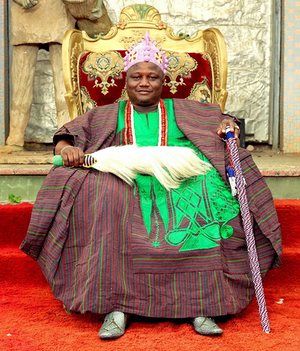
The Ataoja of Osogbo, HRM Oba Jimoh Oyetunji Olanipekun Larooye II, narrated the history of the ancient city of Osogbo, the capital city of Osun State. Our correspondent, who was concerned by some insinuations making the rounds that the Ataoja of Osogbo was a Baale, but not a crowned king, until around 1947, embarked on truth searching research. He stumbled across a Facebook page reportedly posted by the incumbent Ataoja of Osogbo. According to this Facebook’s post by HRM, the Ataoja of Osogbo, Oba Larooye II gave the account of who and when different Ataojas ascended to the throne of Ataoja kingship.
Kabiyesi wrote that the Ataoja, which means the one that “stretches out his hand and takes the fish”, is the traditional ruler of the people of Osogbo.
The following is the list of the Ataojas of Osogbo, with the dates of their reigns as listed by Oba Oyetunji:
1. Oba Larooye Gbadewolu (d. 1760)
2. Oba Sogbodede (d. 1780)
3. Aina Serebu (1780–1810)
4. Abogbe (1810–1812; as Regent, she reigned but did not assume the title Ataoja)
5. Obodegbewale (1812–1815; as Regent)
6. Oba Lahanmi Oyipi (1815–1840)
7. Oba Ojo Adio Okege (1840–1854)
8. Oba Oladejobi Oladele Matanmi I (1854–1864)
9. Oba Fabode.Durosinmi Ogunnike (1864–1891)
10. Oba Bamigbola Alao (1891–1893)
11. Oba Ajayi Olosunde Oyetona (1893–1903)
12. Oba Atanda Olukeye Olugbeja Matanmi II (1903–1917)
13. Oba Kofoworola Ajadi Latona I (1918–1920)
14. Oba Alabi Kolawole (1920–1933)
15. Oba Samuel Oyedokun Latona II (1933–1943)
16. Oba Samuel Adeleye Adenle I (1944–1976)
17. Oba Iyiola Oyewale Matanmi III (1976–2010)
18. Oba Jimoh Oyetunji Olanipekun Larooye II (2010 – till date).
The Kabiyesi further explained that according to the tradition, in Ipole Omu, seven rulers reigned before Olarooye in the following succession: Adefokanbale, Aikanya, Ogbogba, Saso, Luberin, Laege (also known as Adetuturinrin; father to both Lajomo and Larooye), Lajomo and Olarooye.
He noted that during the reign of Oba Olarooye at Ipole, life became very unbearable because of incessant dry seasons. He wrote that then Ipole people became much dejected, worried and uncomfortable over their losses involving their farms, domestic animals and human beings. He added that Oba Olarooye was worried and disheartened by the situation at Ipole Omu, and wanted emergency solutions to inevitable and uncountable losses. The incumbent Ataoja noted that this was the time Oba Olarooye ordered the chief hunter at Ipole-in the person of Timehin and his co-hunters to go on expedition and look for greener pastures. He added that Timehin and the other hunters courageously took up the challenge and moved out in search of a better place for settlement, an expedition that eventually led to the discovery of the River Osun.
Kabiyesi further explained that Yoruba tradition claimed many people fleeing the Fulani Invasion settled in Osogbo following the fall of old Oyo. As a result, Osogbo increased in population largely due to migration from other Yoruba towns. For want of a more open place than a grove and a more central location, Olarooye and his people abandoned their settlement, including the already flourishing market and moved to Ode-Osogbo. Oba Laaroye II further explained that at Ode-Osogbo, Olarooye built his new palace at the present-day Idi-Osun while Timehin built the Ogun shrine, now known as Idi-Ogun. He concluded that since then, Osogbo has maintained her function as an economic center.
With this information from the incumbent Ataoja of Osogbo, HRM Oba Jimoh Oyetunji Olanipekun Larooye II, it is the belief of sons, daughters and lovers of Osogbo that their loved ancient city has always been under the control of crowned kings from time immemorial, except for the interludes during which regents filled any existing vaccum in the leadership.
Leave a Reply